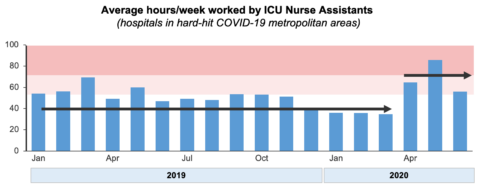Hospitals and health systems across the US and in the UK are using the Laudio platform for one of its core use cases – measuring the indicators of burnout and helping frontline managers react to those indicators in real-time. Over the course of the past few months, I’ve been tracking burnout indicators and how hospitals have been proactively managing them for both nurse and non-nurse roles.
In the US, the New York-Boston metropolitan areas have been the hardest hit by COVID-19 so far. Data from their past few months may be helpful for regions that are now going through similar spikes. Looking at >500 Nurse Assistants (sometimes called CNAs or LNAs), and multiple facilities within this region, one burnout indicator caught my eye: the number of hours per week these team members work.
In the chart below, you can see the average number of hours per week, worked by full-time ICU Nurse Assistants. In general, Nurse Assistants are an unsung hero in hospitals. They spend much of their time with patients, reacting to their need for assistance, and providing them with essential tasks such as repositioning, cleaning, and supporting them when out of bed. Now, during the COVID pandemic, they are among those with the highest risk of disease exposure due to the extended and intimate nature of their contact with patients.
I’ve highlighted the burnout thresholds in red: > 50 hours per week, on average in light red, and > 70 hours per week, on average in dark red.
I observe two things. First, we can see occasions in the past year where the average hours per week has been close to, and occasionally above, 50 hours per week. Managing this group of team members to avoid burnout during normal operations should be considered as a standing goal. But more alarming is that the average hours per week have been above 50 for the past three months – and in the height of the crisis, were above 70.

Our analysis of dozens of hospitals around the country over the past few years has shown this indicator is an early warning signal for burnout and, over time, employee turnover.
Nurse assistants earn between $13-$17 per hour, on average, across the country. Experience has taught us that they often value the financial benefit of having additional hours to work. So, it may be that the team members shown here have been happy with their increase in hours. But managers and leaders have to balance that with a need to avoid burnout and maintain health and safety – something employees aren’t always able to manage that tradeoff for themselves, especially when they are being asked to support a team in crisis
I think this is a great opportunity to recognize this group of team members and celebrate them. But, it’s also a great chance for health systems who are either entering or emerging from a COVID surge to evaluate their staffing and scheduling options to best support and maintain stability within this group.
And, it’s a great time to make sure that we’re doing everything we can to keep them safe and engaged for the coming months and years.